In her 1976 song ‘Amelia’, Joni Mitchell sings: “The drone of flying engines is a song so wild and blue, it scrambles time and seasons if it gets through to you.” Nowhere does this feel more apt than on a flight to Australia, where you can lose an entire calendar day hopping time zones and, if you’re arriving from the opposite hemisphere, two entire seasons.
I felt that disorientation for the first time at the age of eleven, travelling alone to a six-week summer camp outside of Melbourne; there’s something almost lysergic about 24 hours evanescing into the ether. Long-distance journeys can often feel like time is folding back on itself as you move forward.
Sydney
Landing in Sydney decades later, I run across the Harbour Bridge on the morning of my arrival, looking down on the Opera House and the gleaming water beyond. It’s winter here, and oblique sunbeams slice the city into pools of limpid, golden light. I jog past Circular Quay, through the Royal Botanic Gardens and up the steps of the Anzac Memorial, between knee-high Australian white ibis, their black heads lolling, and feel the pull of the land beyond the city.
Australia is the sixth-largest country in the world and occupies about 5% of the planet’s landmass. It is so large that it has a history of swallowing people whole. Australia’s 17th Prime Minister Harold Holt disappeared on 17 December 1967 while swimming at Cheviot Beach, near Portsea, Victoria. In spite of one of the largest search operations in the country’s history, he was never found.
Many explorers have vanished into its distances: Ludwig Leichhardt with his entire party in 1848; Alfred Gibson riding off for water and never seen again. Perhaps that is why it’s interesting to travel by rail – to follow a single, deliberate line across a continent that resists them.
The next morning, at Sydney Central Station, I board the Indian Pacific, played on by a live band. I’m here with Journey Beyond – known for operating luxury rail journeys such as The Ghan and The Overland, the company also runs various lodges and outback tours to connect guests with the landscape.
Clad in ribbed stainless steel and shining in the sun, the Art Deco train stretches across two platforms and, at capacity, can run to nearly a kilometre long. Taking its name from its route, the Indian Pacific travels 4,352km across the continent from ocean to ocean – in my case, from the Pacific to the Indian – over the course of four days and three nights.
Eucalyptus trees cling to limestone crags like icing to a sponge
I’m travelling in Gold Service, which includes a private berth, all meals, drinks and off-train excursions. There’s a tiny shower and a bed that folds into the wall; compact but comprehensive. The train rattles its way out through Sydney’s suburbs and into the Blue Mountains. Ears quickly become accustomed to the ka-chunk of steel wheels hitting rail joints. Eucalyptus trees cling to limestone crags like icing to a sponge.
As the day deepens, the carriage turns amber in the light of the setting sun. Champagne flutes and schooners of beer gleam so brightly they seem in danger of shattering – and one does, in fact. A regular occurrence, explains Thomas Treloar, the train’s Guest Experiences Manager. They average around 40 broken glasses a week.
In the dining car, I sit opposite David Hammond, a retired brewer and winemaker from Griffith, New South Wales, who wears a cashmere jumper. We clink glasses, and he tells me about a trip he took years ago to Queensland after his wife – a passionate collector of French poodles – passed away. He travelled with six of them in a pop-up camper, sometimes sleeping under the stars, watched over by a sextet of loyal canines. “It was crazy,” he says. “But a lot of fun.”
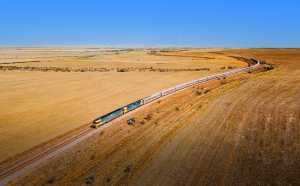
Broken Hill
After the first night, riders wake in a different time zone, the first of three to be crossed, and I feel particularly scrambled when asked to set my watch to ‘train time’. We disembark in Broken Hill, a silver mining town turned out in early morning half-light. The train is dwarfed by a massive slag heap crowned with a curious miner’s monument.
Bleary-eyed passengers rub their eyes and sip coffee before Shelita Buffet makes her entrance – a burst of colour in a grey landscape, like Dorothy stepping into Oz. Towering in heels, dressed in a neon tracksuit and a rainbow wig, Shelita is equal parts drag performer and tour guide. There’s a pun in her name, which takes some tourists a moment to work out. “Let’s walk down to Main Street. Or the main drag, as it were,” she says, her voice amplified by a portable PA. Much of Priscilla, Queen of the Desert was filmed here, and Broken Hill still buzzes with its technicolour legacy.
I spot a basking goanna, then a few feral goats gnawing at the woody stems of saltbush and spinifex
The train carries on deeper into the bush and then the outback. We gaze out the windows at iron-red wilderness, where kangaroo and emu startle at the rumble of the locomotive. I spot a basking goanna, then a few feral goats gnawing at the woody stems of saltbush and spinifex; even the most rugged plants offer moisture.
The enormity of the scene continues to expand, until passengers grow tired of its scale and inevitably turn to the interior places. They play cards in the carriages and make ample use of the bar in the lounge car. A guitarist named James Van Cooper belts out folk songs and sing-alongs. Riders are keen to converse. “I don’t feel the need to travel anywhere else these days,” David Hammond tells me over breakfast, one of the many three-course meals we eat on the journey. “I’m happy exploring my own country.”
Nullarbor Plain
We continue onwards to the longest stretch of straight railway on the planet, 478km across the Nullarbor Plain in the state of South Australia, which comes from the Latin nullus arbor, meaning ‘no trees’. The plain is formerly a shallow limestone seabed, and is monolithically flat, covered in mostly saltbush and bluebush scrub, with summer temps often approaching 50°C, while winter nights can drop below freezing. Gazing out the window, you could be forgiven for thinking that you’re watching a computer’s screensaver repeat itself.
The locomotive pulls into the remote settlement of Cook, named after Australia’s sixth prime minister (who, unlike Holt, didn’t disappear into thin air). Established in 1917 as a service town for the Trans-Australian railway, it’s now classified as an ‘unbounded locality’ within the broader region, counting only 71 people in the 2021 census. Others might refer to it as a ghost town. Its vibes are creaky, dustblown.
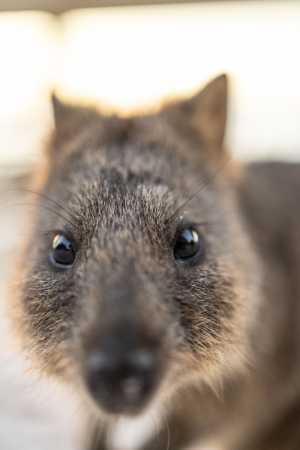
A quokka on Rottnest Island
I’ve been prowling the carriages like a caged cat, desperate to exercise, so I take the opportunity to follow the Cook Road south toward the Great Australian Bight, the enormous bay formed at the bottom of the country when the continent separated from Antarctica. The desert stretching out to either side of the unpaved road is abnormally consistent and unvarying. If it weren’t for the desiccated remains of a deceased lizard, one could be jogging on a treadmill.
Later that evening, shortly after we cross into Western Australia, we stop at Rawlinna, the country’s largest sheep station, which boasts a population of 33 people and around 65,000 merino sheep. As we dine outside, the air redolent of woodsmoke from a crackling bonfire, the sky captivates attention. With almost no artificial light for hundreds of kilometres – and terrain as flat as billiards baize – the stargazing conditions are close to perfect. The Milky Way arcs overhead from horizon to horizon. Thousands of incandescent planets, stars, meteor showers and Magellanic clouds brighten the tiny town.
The next morning, we wake to the purr of the train and the greenery of the Avon River Valley, with patchwork plots of fertile farmland cradled by undulating hills, and the first significant forests that the Indian Pacific has chugged through since the Blue Mountains. Eventually, this fast-flowing tributary decants itself into the broad Swan River, which flows eastwards to the suburbs of Perth, until the city centre’s multi-storey buildings begin to nudge up above the horizon. West-coast, late-afternoon sunbeams stream across the concrete, casting Perth’s streets in a clean, gold luminosity.
Rottnest Island
From Perth, we board a catamaran ferry – the Rottnest Express (also operated by Journey Beyond) – for the 33km commute to the eponymous island, home to quokkas. In 1696, Dutch sea captain Willem de Vlamingh landed on the island and mistook its native quokkas for giant rats. He named it t Eylandt ’t Rottenest, which translates to ‘the island of the rats’ nest’.
Of course, they aren’t rats, but nocturnal marsupials in the same family as kangaroos, which can survive long periods of time without water. They’re nicknamed the happiest animals on the planet for their trademark perma-grin, appearing as if they’re constantly smiling. It’s become a rite of passage for tourists to snap selfies with quokkas, which is perhaps why one was brave enough to purloin a chip from my plate, leaping into my lap to snatch one with its tiny paws. But there’s a lot more to the island than shockingly behaved quokkas.
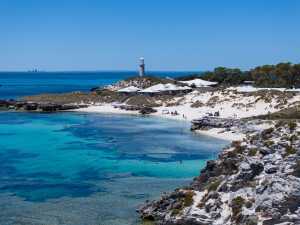
Rottnest Island
Aside from tour buses, there are very few vehicles, making it perfect for bike rides to bountiful white beaches washed by powerful Indian Ocean rollers.
As I change into my togs to jump in, a dark, scaly shadow slithers by my feet. It’s a king’s skink, which can reach up to 55cm in length, and looks up at me with its characteristically snub-nosed snout and inquisitive black eyes, bringing to mind a cute dragon from a children’s film. I prefer it to the mannerless marsupials.
Salt still freckles my sun-warmed skin when the ferry noses back into the harbour in Perth, and the map seems to unroll northward like a ribbon. Western Australia is a vertical epic: keep tracing the shoreline and you pass across three climate zones. The next morning, I follow that invisible meridian by air, climbing out of Perth on a flight that leapfrogs 1,200km of empty sand and scrub to Exmouth, where midwinter feels like a borrowed British July.
Ningaloo Reef
There’s something primordial about the landscape of the Cape Range National Park that leaps out at you. Sitting shotgun in a transport van, I chat with driver Phil Woolaston as he shuttles us down the ruler-straight Yardie Creek Road. Even at midday, the moon hangs heavily above the range, clear enough to see its craters. The peninsula feels ancient, its limestone expanse pocked and karstified with caves, but it’s actually relatively young.
“10 million years ago, this land would have been a coral reef, abruptly pushed upwards as the South Asian Plate edged into the Australian continent and elevated it by a few hundred feet,” Woolaston tells me. “When limestone meets water, it creates carbonic acid, which burns away rock, creating a Unesco heritage landscape cave system with countless unique endemic species.” What’s the strangest? “There are iridescent scorpions living in there.”
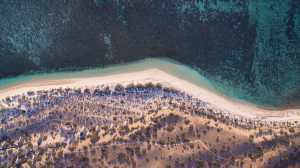
Sal Salis
At Sal Salis, Journey Beyond’s luxury eco-lodge near Ningaloo Reef, I’m greeted with sundowners and sweeping Indian Ocean views. Sixteen canvas tents are tucked into the dunes, just metres from the crashing turquoise surf. Sand clings to my luggage from where it’s been hauled across the boardwalks, bringing to mind Mitchell’s lyrics: “I pulled into the Cactus Tree Motel to shower off the dust / And I slept on strange pillows of my wanderlust.”
The next day, at Tantabiddi Boat Ramp, I meet Justin Bumpstead, a moustachioed diver and wildlife photographer for Live Ningaloo, the operator that is taking us to meet some of the megafauna that favour these shores.
“Ningaloo means ‘deep water’ in the local Aboriginal languages, and supports an explosion of marine wildlife,” he explains. “Massive opposing oceanic currents from Tasmania and Indonesia create healthy conditions, and coral spawn attracts plankton, which in turn supports every form of life up to apex predators such as the 60 species of sharks that frequent these waters, from great hammerheads to tiger sharks.” The shark du jour, however, is of the whale variety.
From the pier, we jump on a small skiff which motors us out to the Wave Rider, a 12m inboard. A Live Ningaloo spotter plane circles above, scanning the reef for animals. While there’s the opportunity to share space with humpback whales, our quarry today is whale sharks, the world’s largest fish, which can reach up to 12 metres.
From the months of March to August every year, 1,770 are known to visit the area of Ningaloo, tracked using their unique spot patterns, which are similar to fingerprints. The waters vary from jade to emerald to cyan, depending on the ocean floor below and the cloud cover above. Blue-spotted lagoon rays and mask rays ripple their wings while wedge-tailed eagles circle above. The Cape Range spans the horizon in a linear plane, banded by ecru beach, retreating as the Wave Rider cruises westward into deeper waters.
Katie Gaites, the resident marine biologist, instructs us to sit on the swim platform on the back of the boat as we approach an eight-metre-long juvenile male whale shark. It feels a bit like waiting your turn to skydive. On her cue, we plunge into the navy-blue water and swim alongside the animal. It’s not the largest specimen, but its sheer size still imbues the situation with a sense of unreality.
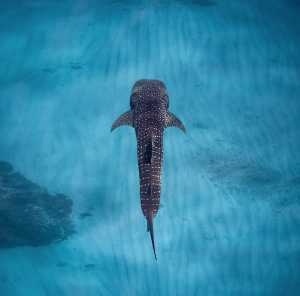
A whale shark near Ningaloo Reef
It’s surprisingly difficult to keep pace with the shark; long, desultory sweeps of the tail propel it forward at speed. When it eventually leaves the group of swimmers behind, the boat retrieves us, then deposits us next to the fish for another sprint. After three, the enormous fish descends into the abyssal waters, its blue skin blending with them until only its white spots are visible, and then not even those. Whale sharks can dive to almost 2,000 metres.
I’m tired when we return to Sal Salis, but before the sun sets, I run north along the road and then peel off eastwards, toward Mandu Mandu Gorge.
As I cross the arid desert plain beneath the range, I startle a flock of rose-breasted cockatoos, sheltering behind a wattle tree, and then a mob of kangaroos, which bound away rapidly. The gorge is named for its pale limestone layer; its chalky, soft texture calves off to create sheer red-and-white cliffs. The track kinks hard left, narrowing into a maroon ravine.
As I crest a drainage, two black-flanked rock wallabies run alongside
It’s a tough climb to the canyon rim, but rewarding. As I crest a drainage, two black-flanked rock wallabies run alongside. The small, distinctively marked marsupials are listed as endangered under Australian law, as are the whale sharks that we swam with earlier that afternoon.
By dusk, the gorge has cooled to shadowed blues, and the desert seems to breathe me back toward camp; not long after, that same breath will lift me skyward. The next morning, when the wheels of the aircraft leave the hot tarmac, the plane’s shadow grows fainter as it retreats from the rust-red earth.
It brings to mind yet another Joni Mitchell line from ‘Amelia’: “six jet planes leaving six white vapour trails across the bleak terrain.” As we climb higher, humpback whales are visible below, sleeping, maybe dreaming, in the sapphire-blue waters of Exmouth Gulf.
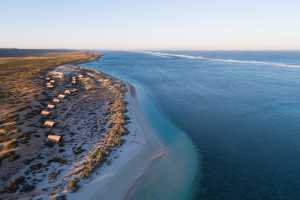
Flight
At the age of 11, I took my first long-haul flight alone, bound for a six-week summer camp at Geelong Grammar School. The programme, Children’s International Summer Villages, brought together 13 delegations from countries around the world.
Once the initial throb of homesickness wore off, I was swept into a rapid-fire succession of firsts: the first extended time away from my family, my first kiss, my first lovelorn farewell. I learned that travel aches.
I learned that travel aches
When you’re on the road, there’s a fresh awareness of the planet spread out before you with its infinite plexus of possibility, and there’s a frustration from being confined to one finite path.
Travel can condense an experience into metaphor – a good journey is like a life in miniature – and that’s apparent now. After two weeks and 5,000km traversing Australia, I’m drawn to reflect on a longer passage, the three decades since that first solo flight, and the railway sleepers that mark the tracks and trajectory of a life, from origin to terminus.
As Mitchell sings, time doesn’t always unfold in straight lines. Seasons scramble. And sometimes, you find yourself looking out over a landscape with the same eyes you had as a child, newly aware of the thread of self that binds you to who you once were, even if every cell in your body has since been replaced three times over.
